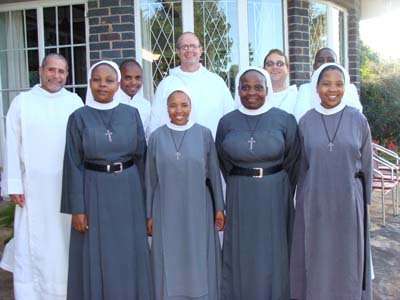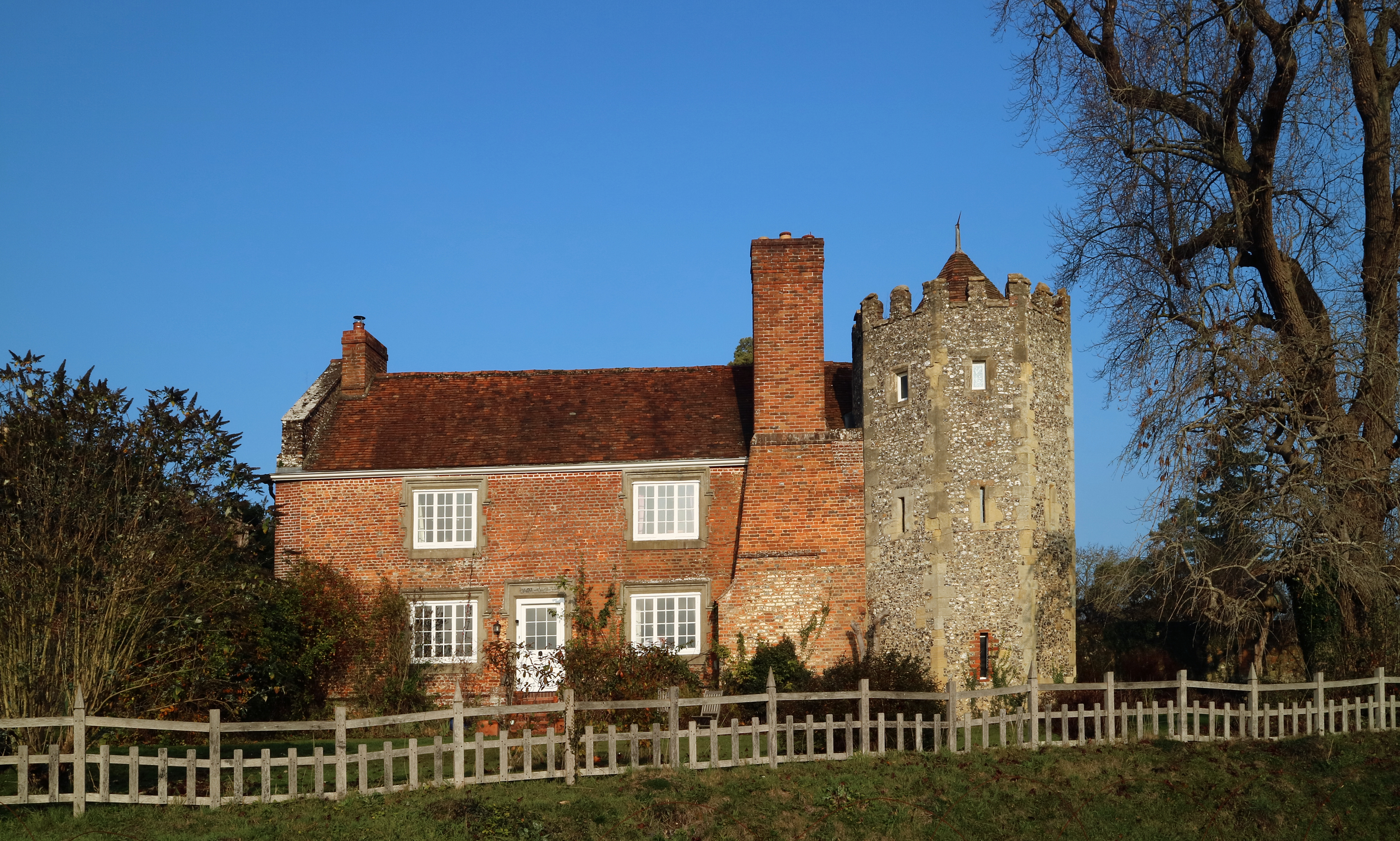|
Community Of The Holy Cross
The Community of the Holy Cross (CHC) is an Anglican religious order founded in 1857 by Elizabeth Neale (sister of John Mason Neale), at the invitation of Father Charles Fuge Lowder, to work with the poor around St Peter's London Docks in Wapping. The Community moved to a large convent in Haywards Heath. The Community later felt drawn to follow the Rule of St Benedict, and moved their convent to Rempstone near Loughborough in 1979, where they lived the monastic life until 2011. The Community then moved a short distance to a new purpose-built convent at Highfields, Costock in Nottinghamshire. The Community aims to achieve the Benedictine balance of prayer, study and work. All work, whether manual, artistic or intellectual, is done within the Enclosure. The daily celebrations of the Eucharist and the Divine Office are the centre and inspiration of all activity. Apart from worship, prayer and intercession, and the work of maintaining the house, garden and grounds, the Community' ... [...More Info...] [...Related Items...] OR: [Wikipedia] [Google] [Baidu] |
Anglican Religious Order
Anglican religious orders are communities of men or women (or in some cases mixed communities of both men and women) in the Anglican Communion who live under a common rule of life. The members of religious orders take vows which often include the traditional monastic vows of poverty, chastity and obedience, or the ancient vow of stability, or sometimes a modern interpretation of some or all of these vows. Members may be laity or clergy, but most commonly include a mixture of both. They lead a common life of work and prayer, sometimes on a single site, sometimes spread over multiple locations. Titles Members of religious communities may be known as monks or nuns, particularly in those communities which require their members to live permanently in one location; they may be known as friars or sisters, a term used particularly (though not exclusively) by religious orders whose members are more active in the wider community, often living in smaller groups. Amongst the friars and ... [...More Info...] [...Related Items...] OR: [Wikipedia] [Google] [Baidu] |
Arthur Wagner
Arthur Douglas Wagner (13 June 1824 – 14 January 1902) was a Church of England clergyman in Brighton, East Sussex, England. He served for more than 50 years at St Paul's Church in the town—first as a curate, then from 1873 as its vicar. As the only son of the Rev. Henry Michell Wagner (Vicar of Brighton for 46 years) and his wife Elizabeth Harriott, who died when he was a child, Arthur Wagner inherited considerable wealth. Following the pattern set by his father—who founded several churches in Brighton—he was able to pay for the construction and endowment of four churches in the town, three of which survive, and another in rural East Sussex where he owned a country estate. Like his father, he became embroiled in disputes and controversy: he held strongly Tractarian views and was often criticised for the advanced ritualism of the services he held at St Paul's, while his involvement in the Constance Kent affair caused national debate about priest–penitent privilege. Wa ... [...More Info...] [...Related Items...] OR: [Wikipedia] [Google] [Baidu] |
Religious Organizations Established In 1857
Religion is usually defined as a social-cultural system of designated behaviors and practices, morals, beliefs, worldviews, texts, sanctified places, prophecies, ethics, or organizations, that generally relates humanity to supernatural, transcendental, and spiritual elements; however, there is no scholarly consensus over what precisely constitutes a religion. Different religions may or may not contain various elements ranging from the divine, sacred things, faith,Tillich, P. (1957) ''Dynamics of faith''. Harper Perennial; (p. 1). a supernatural being or supernatural beings or "some sort of ultimacy and transcendence that will provide norms and power for the rest of life". Religious practices may include rituals, sermons, commemoration or veneration (of deities or saints), sacrifices, festivals, feasts, trances, initiations, funerary services, matrimonial services, meditation, prayer, music, art, dance, public service, or other aspects of human culture. Religions have sa ... [...More Info...] [...Related Items...] OR: [Wikipedia] [Google] [Baidu] |
Anglican Orders And Communities
Anglicanism is a Western Christian tradition that has developed from the practices, liturgy, and identity of the Church of England following the English Reformation, in the context of the Protestant Reformation in Europe. It is one of the largest branches of Christianity, with around 110 million adherents worldwide . Adherents of Anglicanism are called ''Anglicans''; they are also called ''Episcopalians'' in some countries. The majority of Anglicans are members of national or regional ecclesiastical provinces of the international Anglican Communion, which forms the third-largest Christian Communion (Christian), communion in the world, after the Roman Catholic Church and the Eastern Orthodox Church. These provinces are in full communion with the See of Canterbury and thus with the Archbishop of Canterbury, whom the communion refers to as its ''Primus inter pares#Anglican Communion, primus inter pares'' (Latin, 'first among equals'). The Archbishop calls the decennial Lambeth ... [...More Info...] [...Related Items...] OR: [Wikipedia] [Google] [Baidu] |
Bunny Hall
Bunny Hall is a grade I listed country house in Bunny, Nottinghamshire. The house was originally an Elizabethan red brick house with an 80 foot high tower. The house was rebuilt in 1720 by Sir Thomas Parkyns, 2nd Baronet and now stands in of formal gardens and parkland. It has been equipped with a cinema room and a leisure area equipped with gymnasium, steam and sauna rooms, a large indoor heated pool and separate Jacuzzi and spa area. There is also a large orangery, drawing room, library and a circular glazed frosted dome allowing light to illuminate the hallway and staircase. The hall is listed Grade I on the National Heritage List for England. Several buildings and structures associated with the hall are listed Grade II; these include the stable block, an out building to the north, a barn dating from 1734, the carriage archway and barns, and the garden walls and garden outbuildings, and the gate piers and walls around the park. A chest tomb near the hall and the sundia ... [...More Info...] [...Related Items...] OR: [Wikipedia] [Google] [Baidu] |
Dower House
A dower house is usually a moderately large house available for use by the widow of the previous owner of an English, Scottish or Welsh estate. The widow, often known as the "dowager", usually moves into the dower house from the larger family house on the death of her husband if the heir is married, and upon his marriage if he was single at his succession. The new heir occupies the now vacated principal house. The dower house might also be occupied by an elder son after his marriage, or simply rented to a tenant. Examples The British royal family maintains a dower house in London as well as one in the country. Well-known royal dower-houses in London have included Clarence House, Marlborough House, and (for a time during the 18th century) Buckingham Palace (then known as "Buckingham House"). Rappaport, Helen (2003)''Queen Victoria: A Biographical Companion'' p. 83. ABC-CLIO, Inc. Frogmore House has served as Windsor Castle's dower house. The Dukes of Devonshire kept Hardwic ... [...More Info...] [...Related Items...] OR: [Wikipedia] [Google] [Baidu] |
A60 Road
The A60 is a road linking Loughborough in Leicestershire, England, with Doncaster in South Yorkshire, via Nottingham. It takes the following route: * ** ** ** ** ** |
Diocese Of Southwell
The Diocese of Southwell and Nottingham is a Church of England diocese in the Province of York, headed by the Bishop of Southwell and Nottingham. It covers all the English county of Nottinghamshire and a few parishes in South Yorkshire. It is bordered by the dioceses of Derby, Leicester, Lincoln and Sheffield. The cathedral, Southwell Minster, is in the town of Southwell, 15 miles (24 km) north of Nottingham. History Until 2005 the diocese was named simply Southwell, but in February the diocesan synod requested a change of name, which was approved by the General Synod of the Church of England in July and by the Privy Council on 15 November 2005. The present territory of the diocese was originally the Archdeaconry of Nottingham in the Diocese of York, before it was moved in 1837 to the Diocese of Lincoln (so switching from the Province of York to the Province of Canterbury). On 5 February 1884 it was taken from Lincoln and united with the archdeaconry of Derby (covering, roug ... [...More Info...] [...Related Items...] OR: [Wikipedia] [Google] [Baidu] |
Enclosed Religious Orders
Enclosed religious orders or ''cloistered clergy'' are religious orders whose members strictly separate themselves from the affairs of the external world. In the Catholic Church, enclosure is regulated by the code of canon law, either the Latin code or the Oriental code, and also by the constitutions of the specific order.The Code of Canon Law, Canon 667 ff. English translation copyright 1983 The Canon Law Society Trust It is practised with a variety of customs according to the nature and charism of the community in question. This separation may involve physical barriers such as walls and grilles (that is, a literal cloister), with entry restricted for other people and certain areas exclusively permitted to the members of the convent. Outsiders may only temporarily enter this area under certain conditions (for example, if they are candidates for the order, doctors or craftsmen). The intended purpose for such enclosure is to prevent distraction from prayer and the religious li ... [...More Info...] [...Related Items...] OR: [Wikipedia] [Google] [Baidu] |
Richard Meux Benson
Richard Meux Benson (6 July 1824 – 14 January 1915) was a priest in the Church of England and founder of the Society of St. John the Evangelist, the first religious order of monks in the Anglican Communion since the Reformation. He is commemorated in the Calendar of Saints of the Anglican Church of Canada on 15 January and on the Episcopal Church calendar on January 14 with Charles Gore. Early life Benson was born into a wealthy London family in 1824, the son of merchant Thomas Starling Benson and his second wife, Elizabeth Meux, daughter of Richard Meux. Henry Roxby Benson was his elder brother.''London, England, Church of England Births and Baptisms, 1813–1917'' Benson was taught at home by a private tutor and entered Christ Church, Oxford. After his degree and ordination and a curacy at Surbiton, in 1850 he became vicar of Cowley, Oxford. He was considered High Church. In 1858, Benson conducted a retreat for priests using material taken in part from the Spiritual ... [...More Info...] [...Related Items...] OR: [Wikipedia] [Google] [Baidu] |
Haywards Heath
Haywards Heath is a town in West Sussex, England, south of London, north of Brighton, south of Gatwick Airport and northeast of the county town, Chichester. Nearby towns include Burgess Hill to the southwest, Horsham to the northwest, Crawley northwest and East Grinstead northeast. With only a relatively small number of jobs available in the immediate vicinity, mostly in the agricultural or service sector, many residents work "remotely" or commute daily via road or rail to London, Brighton, Crawley or Gatwick Airport for work. Etymology The first element of the place-name Haywards Heath is derived from the Old English ''hege'' + ''worð'', meaning hedge enclosure, with the later addition of ''hǣð''. The place-name was first recorded in 1261 as ''Heyworth'', then in 1359 as ''Hayworthe'', in 1544 as ''Haywards Hoth'' (i.e. 'heath by the enclosure with a hedge'), and in 1607 as ''Hayworths Hethe''. There is a local legend that the name comes from a highwayman who went under ... [...More Info...] [...Related Items...] OR: [Wikipedia] [Google] [Baidu] |






